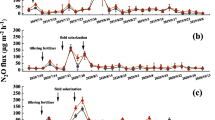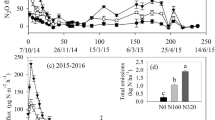Abstract
Irrigation is known to stimulate soil microbial carbon and nitrogen turnover and potentially the emissions of nitrous oxide (N2O) and carbon dioxide (CO2). We conducted a study to evaluate the effect of three different irrigation intensities on soil N2O and CO2 fluxes and to determine if irrigation management can be used to mitigate N2O emissions from irrigated cotton on black vertisols in South-Eastern Queensland, Australia. Fluxes were measured over the entire 2009/2010 cotton growing season with a fully automated chamber system that measured emissions on a sub-daily basis. Irrigation intensity had a significant effect on CO2 emission. More frequent irrigation stimulated soil respiration and seasonal CO2 fluxes ranged from 2.7 to 4.1 Mg-C ha−1 for the treatments with the lowest and highest irrigation frequency, respectively. N2O emission happened episodic with highest emissions when heavy rainfall or irrigation coincided with elevated soil mineral N levels and seasonal emissions ranged from 0.80 to 1.07 kg N2O-N ha−1 for the different treatments. Emission factors (EF = proportion of N fertilizer emitted as N2O) over the cotton crop** season, uncorrected for background emissions, ranged from 0.40 to 0.53 % of total N applied for the different treatments. There was no significant effect of the different irrigation treatments on soil N2O fluxes because highest emission happened in all treatments following heavy rainfall caused by a series of summer thunderstorms which overrode the effect of the irrigation treatment. However, higher irrigation intensity increased the cotton yield and therefore reduced the N2O intensity (N2O emission per lint yield) of this crop** system. Our data suggest that there is only limited scope to reduce absolute N2O emissions by different irrigation intensities in irrigated cotton systems with summer dominated rainfall. However, the significant impact of the irrigation treatments on the N2O intensity clearly shows that irrigation can easily be used to optimize the N2O intensity of such a system.





Similar content being viewed by others
References
Almagro M, López J, Querejeta JI, Martínez-Mena M (2009) Temperature dependence of soil CO2 efflux is strongly modulated by seasonal patterns of moisture availability in a Mediterranean ecosystem. Soil Biol Biochem 41(3):594–605. doi:10.1016/j.soilbio.2008.12.021
ANGA (2010) Australian National Greenhouse Accounts National Inventory Report 2008, vol 1. Department of Climate Change and Energy Efficiency
Barton L, Kiese R, Gatter D, Butterbach-Bahl K, Buck R, Hinz C, Murphy DV (2008) Nitrous oxide emissions from a cropped soil in a semi-arid climate. Glob Change Biol 14(1):177–192
Bouwman AF, Boumans LJM, Batjes NH (2002) Modeling global annual N2O and NO emissions from fertilized fields. Glob Biogeochem Cycles 16(4). doi:10.1029/2001gb001812
Breuer L, Papen H, Butterbach-Bahl K (2000) N2O emission from tropical forest soils of Australia. J Geophys Res Atmos 105(D21):26353–26367
Bryan B, Marvanek S (2004) Quantifying and valuing land use change for integrated catchment management evaluation in the Murray-Darling Basin 1996/97–2000/01. CSIRO Land and Water, Adelaide
Denmead OT, Macdonald BCT, Bryant G, Naylor T, Wilson S, Griffith DWT, Wang WJ, Salter B, White I, Moody PW (2010) Emissions of methane and nitrous oxide from Australian sugarcane soils. Agric For Meteorol 150(6):748–756. doi:10.1016/j.agrformet.2009.06.018
Dobbie KE, McTaggart IP, Smith KA (1999) Nitrous oxide emissions from intensive agricultural systems: variations between crops and seasons, key driving variables, and mean emission factors. J Geophys Res Atmos 104(21):26891–26899. doi:10.1029/1999jd900378
FAO (1996) Rome declaration on world food security and worldfood summit plan of action. Food and Agriculture Organization of the United Nations, Rome
FAO (1998) World reference base for soil resources. World soil resources, vol 84. Rome
Galbally I, Meyer M, Bentley S, Weeks I, Leuning R, Kelly K, Phillips F, Barker-Reid F, Gates W, Baigent R, Eckard R, Grace P (2005) A study of environmental and management drivers of non-CO2 greenhouse gas emissions in Australian agro-ecosystems. Environ Sci 2(2–3):133–142. doi:10.1080/15693430500395396
Han G, Zhou G, Xu Z, Yang Y, Liu J, Shi K (2007) Biotic and abiotic factors controlling the spatial and temporal variation of soil respiration in an agricultural ecosystem. Soil Biol Biochem 39(2):418–425. doi:10.1016/j.soilbio.2006.08.009
Högberg P, Nordgren A, Ågren G (2002) Carbon allocation between tree root growth and root respiration in boreal pine forest. Oecologia 132(4):579–581. doi:10.1007/s00442-002-0983-8
IPPC (2006) Guidelines for National Greenhouse Gas Inventories, prepared by the National Greenhouse Gas Inventories Programme. IGES, Japan
Jenerette GD, Scott RL, Huxman TE (2008) Whole ecosystem metabolic pulses following precipitation events. Funct Ecol 22(5):924–930. doi:10.1111/j.1365-2435.2008.01450.x
Kiese R, Butterbach-Bahl K (2002) N2O and CO2 emissions from three different tropical forest sites in the wet tropics of Queensland, Australia. Soil Biol Biochem 34:975–987
Lesschen JP, Velthof GL, de Vries W, Kros J (2011) Differentiation of nitrous oxide emission factors for agricultural soils. Environ Pollut 159(11):3215–3222. doi:10.1016/j.envpol.2011.04.001
Linn DM, Doran JW (1984) Effect of water-filled pore space on carbon dioxide and nitrous oxide production in tilled and nontilled soils. Soil Sci Soc Am J 48:1264–1272
Liu CY, Zheng XH, Zhou ZX, Han SH, Wang YH, Wang K, Liang WG, Li M, Chen DL, Yang ZP (2010) Nitrous oxide and nitric oxide emissions from an irrigated cotton field in Northern China. Plant Soil 332(1–2):123–134. doi:10.1007/s11104-009-0278-5
Mahmood T, Ali R, Iqbal J, Robab U (2008) Nitrous oxide emission from an irrigated cotton field under semiarid subtropical conditions. Biol Fertil Soils 44(5):773–781. doi:10.1007/s00374-008-0276-4
Mu Z, Huang A, Kimura SD, ** T, Wei S, Hatano R (2009) Linking N(2)O emission to soil mineral N as estimated by CO(2) emission and soil C/N ratio. Soil Biol Biochem 41(12):2593–2597. doi:10.1016/j.soilbio.2009.09.013
Parkin TB, Kaspar TC (2003) Temperature controls on diurnal carbon dioxide flux: implications for estimating soil carbon loss. Soil Sci Soc Am J 67(6):1762–1772
Raich JW, Schlesinger WH (1992) The global carbon-dioxide flux in soil respiration and its relationship to vegetation and climate. Tellus B Chem Phys Meteorol 44(2):81–99
Rochester IJ (2003) Estimating nitrous oxide emissions from flood-irrigated alkaline grey clays. Aust J Soil Res 41:197–206
Scheer C, Wassmann R, Klenzler K, Lbragimov N, Eschanov R (2008) Nitrous oxide emissions from fertilized irrigated cotton (Gossypium hirsutum L.) in the Aral Sea Basin, Uzbekistan: influence of nitrogen applications and irrigation practices. Soil Biol Biochem 40(2):290–301. doi:10.1016/j.soilbio.2007.08.007
Scheer C, Grace PR, Rowlings DW, Payero J (2012) Nitrous oxide emissions from irrigated wheat in Australia: impact of irrigation management. Plant Soil 359(1–2):351–362. doi:10.1007/s11104-012-1197-4
Skiba UM, Sheppard LJ, MacDonald J, Fowler D (1998) Some key environmental variables controlling nitrous oxide emissions from agricultural and semi-natural soils in Scotland. Atmos Environ 32(19):3311–3320. doi:10.1016/s1352-2310(97)00364-6
Smith P, Martino D, Cai Z, Gwary D, Janzen H, Kumar P, McCarl B, Ogle S, O’Mara F, Rice C, Scholes B, Sirotenko O (2007) Agriculture. In: Metz B, Davidson OR, Bosch PR, Dave R, Meyer LA (eds) Climate change 2007: mitigation. Contribution of Working Group III to the fourth assessment report of the intergovernmental panel on climate change. Cambridge University Press, New York
Stehfest E, Bouwman L (2006) N2O and NO emission from agricultural fields and soils under natural vegetation: summarizing available measurement data and modeling of global annual emissions. Nutr Cycl Agroecosyst 74(3):207–228. doi:10.1007/s10705-006-9000-7
US-EPA (2006) Global anthropogenic non-CO2 greenhouse gas emissions: 1990–2020. United States Environmental Protection Agency, EPA 430-R-06-003, Washington, DC
Wang H, McConkey B, Curtin D, Cutforth H (2010) Estimation of daily soil CO2 flux using a single-time-point measurement. Can J Soil Sci 90(3):517–522
Werner C, Zheng XH, Tang JW, **e BH, Liu CY, Kiese R, Butterbach-Bahl K (2006) N2O, CH4 and CO2 emissions from seasonal tropical rainforests and a rubber plantation in Southwest China. Plant Soil 289(1–2):335–353. doi:10.1007/s11104-006-9143-y
Zheng X, Wang M, Wang Y, Shen R, Gou J, Li J, ** J, Li L (2000) Impacts of soil moisture on nitrous oxide emission from croplands: a case study on the rice-based agro-ecosystem in Southeast China. Chemos Glob Change Sci 2(2):207–224. doi:10.1016/s1465-9972(99)00056-2
Acknowledgments
We thank Geoff Robinson for his valuable help in the field measuring campaign. The Department of Employment, Economic Development & Innovation (DEEDI) for providing the study site and the farm staff for planting and harvesting the experimental plots. This research was undertaken as part of the national Nitrous Oxide Research Program (NORP) funded by the Grains Research and Development Corporation (GRDC) and Department of Agriculture, Fishery and Forestry (DAFF).
Author information
Authors and Affiliations
Corresponding author
Rights and permissions
About this article
Cite this article
Scheer, C., Grace, P.R., Rowlings, D.W. et al. Soil N2O and CO2 emissions from cotton in Australia under varying irrigation management. Nutr Cycl Agroecosyst 95, 43–56 (2013). https://doi.org/10.1007/s10705-012-9547-4
Received:
Accepted:
Published:
Issue Date:
DOI: https://doi.org/10.1007/s10705-012-9547-4




